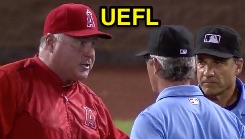 |
| Phil Cuzzi explains his ruling to Scioscia. |
Scioscia protested HP Umpire Phil Cuzzi's ruling that Mondesi did not interfere and the Angels ultimately lost the contest. Ahead of MLB BOC's decision, let us review the play.
Official Baseball Rule 5.09(a)(11) states that a batter is out for runner's lane interference when—
In running the last half of the distance from home base to first base, while the ball is being fielded to first base, he runs outside (to the right of) the three-foot line, or inside (to the left of) the foul line, and in the umpire’s judgment in so doing interferes with the fielder taking the throw at first base, in which case the ball is dead.
 |
| Mondesi beats the play at first base. |
Interpretations of RLI: If you've followed our extensive series on runner's lane interference (see: Officially Speaking - RLI Part One and Part Deux, as well as 2015's RLI Analysis and 2016's RLI Only Applies to Fielder at First), you'll also be familiar with Jim Evans' interpretation that, "A runner who has advanced the entire distance from home plate to first in fair territory making no effort to run within the lane is not extended the same leniency as the runner who runs in the lane as required and then cuts into fair territory near the base to touch it," and Harry & Hunter Wendelstedt's interpretation that, "The determination is not whether the throw is true, but whether it could still reasonably retire the runner."
 |
| Scioscia takes his protest to Paul Nauert. |
Applying the Rule: The Evans interpretation is straightforward and visual evidence proves Mondesi advanced the entire distance in fair territory and not within his lane. What you'll notice from the Wendelstedt interpretation regarding quality of throw, however, is that the determining factor on whether to call RLI is to consider, "whether [the throw] could still reasonably retire the runner."
If you believe that Mondesi would have been safe at first base in spite of that throw and that Mondesi beat the ball to the fielder, then, pursuant to Wendelstedt, the throw could not have still reasonably retired the runner (since he beat the throw to begin with), and, with that criterion unsatisfied, RLI cannot apply to the play.
Under this interpretation, Cuzzi's call was correct and the Angels will lose their protest.
 |
| Scioscia pleads as Counselor Bellino observes. |
Put another way, OBR/MLBUM do not corroborate nor refute Evans/Wendelstedt. Therefore, MLB will have to rule on a rules-grey area over whether Scioscia's argument has merit. For that to happen, it will also rely on Cuzzi to have declared that Mondesi's actions would have constituted interference, but for the fact that he already reached first base prior to the "no catch" event. If so, MLB has room to rule either way, although Wendelstedt makes it quite clear that because the throw could not have retired the runner, no-calling RLI probably is a wise decision.
The last Angels protest occurred in 2013 when Fieldin Culbreth's crew allowed Houston to replace an incoming pitcher, who had yet to throw a pitch, while Scioscia filed a previous protest concerning RLI in 2012, claiming that the opposing batter-runner's running outside of the 45-foot lane caused the catcher to throw wildly to first base (the Angels lost that protest, as RLI only applies to the fielder taking the throw).
Alternate Link: Raul Mondesi records his first big league hit on disputed, protested play (KC)










0 comments :
Post a Comment